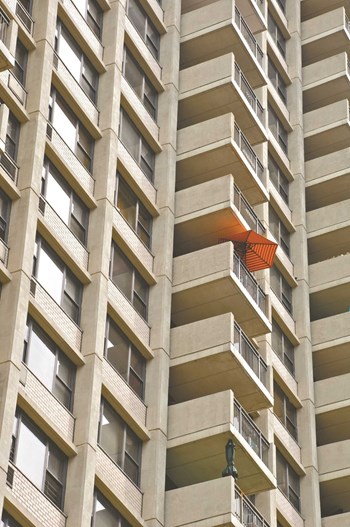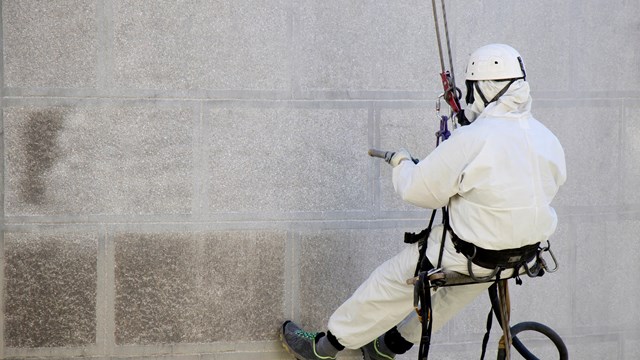
It’s no secret—living space is at a premium in New York City. Balconies can go a long way toward providing a little extra elbow room by giving co-op and condo residents the square footage necessary to entertain, relax or simply enjoy a view of the sunset.
As with any structure, balconies need a steady diet of care and maintenance to look their best and last their longest. By planning for that care, boards and managers can save money, ensure safety and preserve the aesthetic value of their balcony spaces. And with the right outlook, maintenance and repair can be relatively painless.
How They’re Built
These days, the vast majority of New York balconies are made from steel and concrete, with a smaller percentage of wooden structures represented in the mix. There are two kinds of concrete balconies: continuous slab, which is simply an extension of a building’s concrete floor slab and those that are constructed from steel frames that are mounted to the structure. Steel planks extend from the building’s frame and are then filled with concrete. On both types of balconies, railings are added after initial construction and are either embedded into the concrete of the balcony or surface mounted.
Wooden balconies are constructed in much the same way with beams run into the unit so that they become part of the flooring system. Again, railings are added at the end of the process.
What Can Go Wrong
There is one very important reason that any and all balcony professionals tell their clients that proper maintenance and care is vital—and that’s the fact that balconies, when they go bad, can be very expensive to fix and also pose a serious hazard. With wooden balconies, for example, a couple of different scenarios can play out without the proper maintenance or initial installation. If too much pressure is exerted on the wooden cantilever—half of which is under the unit’s floor and the other half of which serves as the balcony’s floor —that pressure can cause sagging which will affect the stability of the floor inside.
Or if the girders themselves start to rot on the outside of the building, then the cost to remove those beams and start again is enormous. “You have to open up the ceiling of the person in the unit below, and tear out electrical and plumbing, insulation and sheet rock,” says Sean McAleer, owner of Deck Medic Inc. and Deck Remodeler, and a specialist in wooden decks and balconies. “It’s a matter of coordinating all of these different trades to get the repair done. We’ve dealt with this a lot, and it can be a huge problem.”
With concrete balconies, the most common problems are cracking concrete and spalling, which is created by the oxidation of the reinforcing bar in the concrete, says Stan Wellinsky, vice president of Valcourt Building Services of New Jersey. These problems are caused by “snow and ice or poor construction, such as not enough concrete to cover over the steel. Concrete protects the steel from corrosion. If it’s a half-inch thick instead of an inch thick, the elements can get down into the reinforcing bar, corroding them sooner than they would otherwise.”
As with most architectural elements exposed to the weather, water is a huge factor in deterioration. “Once water is allowed to penetrate any opening in the deck, a series of thermal cycles along with the trapped water freezing and thawing, will continue to expand the opening and cause further deterioration of the concrete and create rusting of metal support structures,” says David Saias, executive vice president of Gotham Waterproofing & Restoration in New York and Bayonne, New Jersey. “Items placed on top of the surface that can trap water—like outdoor carpets or plants—also can contribute to the problem.”
Water problems also can arise from improperly pitched balconies where the slope of the balcony is either not in the right direction or is not sloped enough to allow the water to run off and prevent it from collecting and sitting stagnant.
In addition to cracks, chips and other corrosive dangers, balconies also often suffer from the effects of untreated railings. When railing posts are installed directly into the concrete, the aluminum can create a galvanic response, leading to corrosion. “You can install railings into concrete but the metal needs to have a protective coating,” says Wellinsky. “Incorrect installation or not enough protective coating is what causes problems.”
Spotting the Problem
Knowing what might be wrong starts with knowing what a healthy baseline is for each balcony, says Saias. The maintenance staff or property manager should then do a visual inspection once every spring, documenting any problems he or she sees. If there’s a crack two inches long, it should be listed on a spreadsheet. This establishes benchmarks early on and allows the maintenance person to check back during the next inspection and see if the crack has grown, spread or changed in any way. If management knows of problems in similarly-designed balconies, then annual inspections should be turned into quarterly inspections.
As part of the inspection, people also should be on the lookout for rust marks and efflorescence, a powdery white substance that can form on the stone and concrete surfaces. “If you see those little white stalactites hanging there, those are signs that water is migrating through the concrete,” says Wellinsky. And if the inspection is taking place while it’s still chilly, any signs of icicles hanging from the bottom of the concrete is also a sign that water is working its way through and is perhaps well on its way to causing cracks to form or expand.
In addition to cracks on the deck, fascia or the underside of the balcony, inspectors should be looking for signs of coating that is starting to peel as well as for exposed rebar or loose concrete or railings, says Saias. “Spalled concrete or flaking and pitting of the surface can indicate additional damage not readily observed.”
In wooden balconies, signs of degradation can include mildew, staining and fading.
If the property manager or maintenance crew spots signs of problems, then their next step should be calling a balcony or construction professional to determine the severity of the problem. Even e-mailing digital photos to a trusted expert can help determine cause and potential solutions.
All About the Maintenance
“There is no common cure for a lack of maintenance,” says Wellinsky. “If you stay on top of maintenance by sealing cracks and using clear coatings, your costs are going to be severely reduced, and you’re going to put some longevity into your ownership.”
With proper maintenance, balconies can last generations. “There’s no reason that concrete balconies can’t last 50 years,” Wellinsky says. “And on the other hand, the balconies on some buildings built five years ago need to be completely restored.”
Wooden decks, for example, “should be washed and sealed every two years,” says McAleer. “A lot of places are on a three-year cycle but then what you get is one year of maintenance and two years of water damage. Even if a product says it will last three years, you should do it every two.”
A lot of maintenance harkens back to simply doing things right during the building process and staying on top of a regular sealing, coating and care schedule. Corrosion problems may have started before the first residents even moved into the building. Exposure to water or salt could have taken place before the concrete was even added, or in older buildings, contractors may have added a concrete accelerator to the mix and that accelerator contained salt, which in turn causes corrosion.
Location, too, might factor into how often a balcony should be maintained and the level of diligence necessary for its preservation. “The closer to salt water you are, the sooner corrosion is going to happen,” says Wellinsky. Carbon dioxide from heavy traffic also can play a number on the health and well-being of concrete and steel.
Acting quickly when problems occur can help minimize damage. Repair strategies might include “resurfacing the balcony deck, fascia and underside with concrete deck coating material,” says Saias. “Utilizing concrete repair mortar for surface cracks and hairline cracks, and using a concrete patching product for spall repair” are also key. For rust issues, the removal of that rust “from exposed metal rebars or wire mesh and the application of a rust inhibitor coating” will likely solve the problem, adds Saias. And finally, “loose railing posts should be reset in non-shrink grout with the penetration fully caulked.”
While these repairs can take anywhere from a couple of hours to several weeks for a complete replacement, they are well worth the time and effort.
Balconies are our places of refuge and our doors into the natural world. They’re among our most prized pieces of real estate—certainly that’s something worth protecting.
Liz Lent is a freelance writer and a frequent contributor to The Cooperator.






2 Comments
Leave a Comment